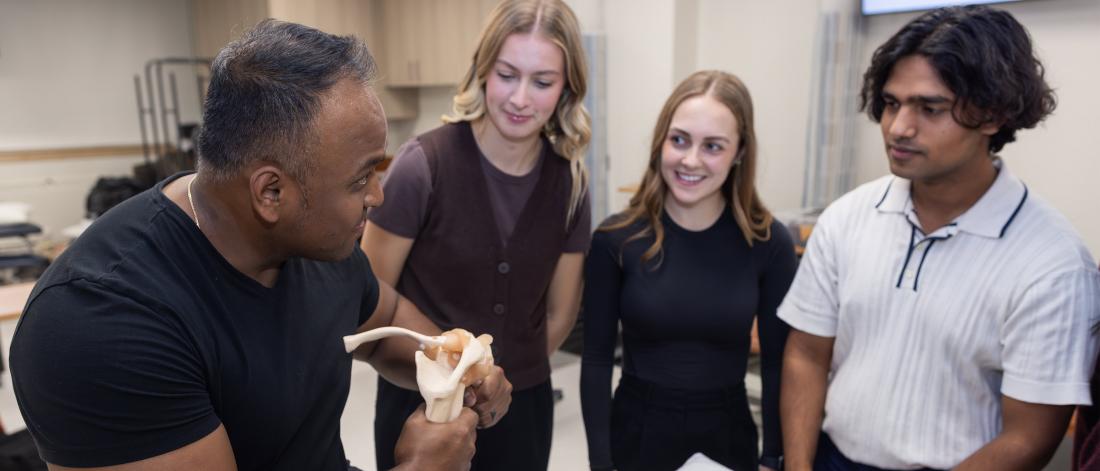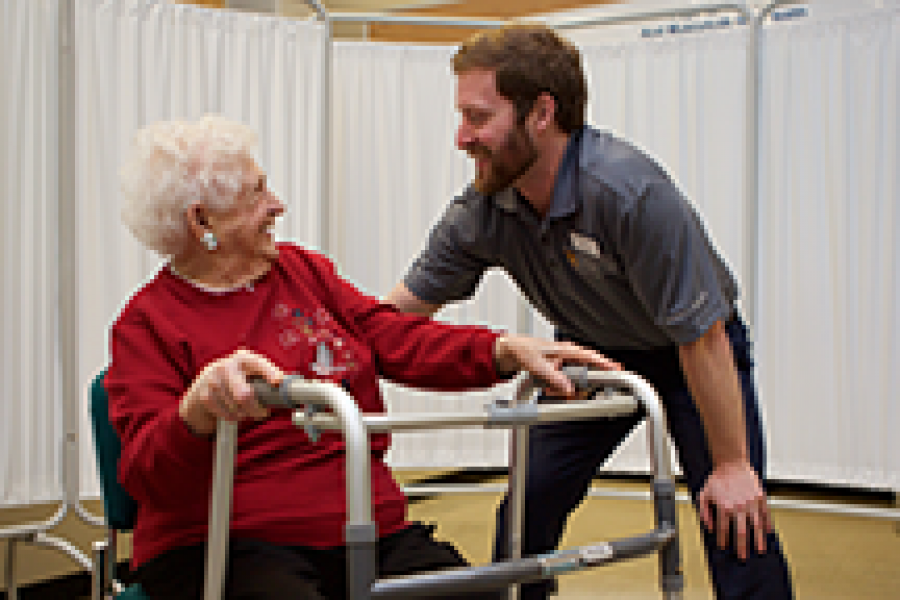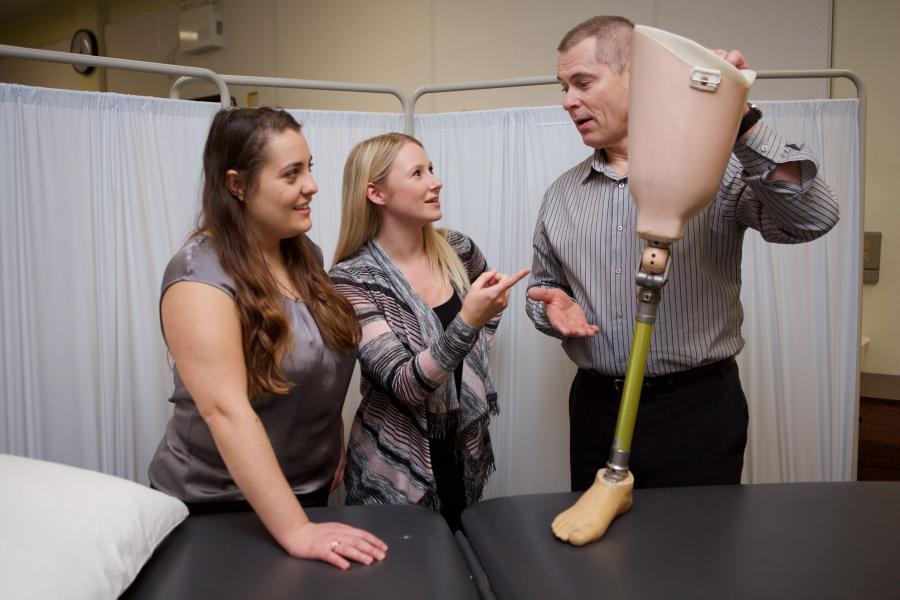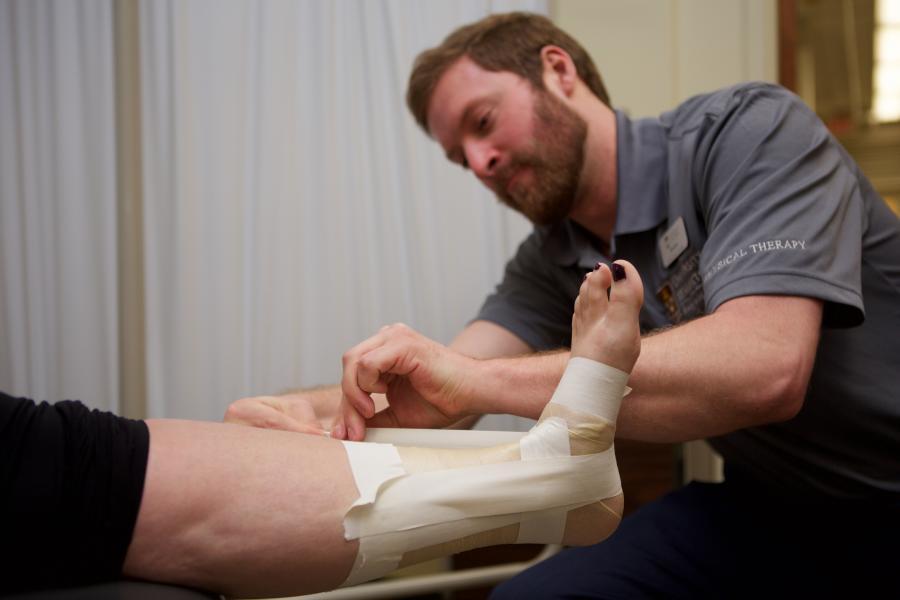Department of Physical Therapy
What we offer
Student experience
Internationally educated health professionals
Clinical education
The clinical education component of the MPT program is a series of practice-based courses interspersed throughout both years of the program.
These courses provide students with the opportunity to transfer their knowledge and skills from the classroom into real life physical therapy practice, gain confidence and develop strong patient care skills.
Students work alongside experienced clinical educators in the community. Opportunities are provided throughout the province in a variety of health care settings, including private physiotherapy clinics, community rehabilitation centers and acute hospital-based care.
Program details
General schedule for clinical placements
MPT placements
Students will experience placements in a hospital, community/rehabilitation, and private practice setting throughout the program where they will work with clients with a variety of health conditions, including, but not limited to, neuromusculoskeletal, neurological, cardiovascular and pulmonary.
| Year | Placement Period | Description |
|---|---|---|
| Year 1 | April – August | One 6-week placement in a hospital, community/rehabilitation or private practice setting. |
| Year 2 | October – December | Two 6-week placements in either a hospital, community/rehabilitation or private practice setting. |
| April – August | Two 6-week placements in either a hospital, community/rehabilitation or private practice setting. |
Expectations of clinical instructors
Requirements
To be a clinical instructor you must:
- Be a fully licensed physiotherapist in good standing with the regulatory body (College of Physiotherapists of Manitoba for MB clinicians)
- Have a minimum of one full year of clinical experience
We strongly recommend educators complete the training modules from Western University (available in the clinical instructor resources section)
Expectations
As a clinical instructor, you are expected to:
- Be a positive role model
- Prepare your workplace/caseload in advance of the student’s start date
- Provide an orientation
- Make time to assist the student and provide supervision based on the student’s level of experience
- Offer learning opportunities that allow the student to fulfill their learning objectives, as discussed with the student using the Clinical Learning Contract
- Provide feedback and encourage student self-reflection at appropriate intervals to promote continuous learning
- Complete the ACP evaluation tool at midterm and final with the student
- Contact the academic coordinator of clinical education if you have any concerns about student performance
Clinical instructor resources
Western University Preceptor Education Program (PEP)
The Preceptor Education Program at Western University is an online resource aimed at preparing students and clinical instructors for clinical placements. It strongly recommends completing the feedback module before the student placement begins.
Past clinical educator workshops
Before each round of clinical rotations in the spring and fall, the Clinical Education team organizes workshops tailored for both new and experienced clinicians. If unable to attend in person, past workshops are available for viewing. Check out the workshop titled “Setting up for Success” on YouTube.
Canadian Physiotherapy Assessment of Clinical Performance (ACP) 2.0 online learning module
The ACP serves as the evaluation tool for all clinical placements at the University of Manitoba. It is completed by both students and clinical instructors at midterm and final stages. The ACP 2.0 online learning module offers a self-paced approach to understanding the tool and provides guidance on completion. Clinicians are encouraged to review this module before supervising students.
HSPnet
All ACP evaluations for University of Manitoba students are conducted through HSPnet. Upon student allocation, an email containing access instructions will be sent from HSPnet. Please check your junk mail folder as this email might be filtered. For any HSPnet-related issues, reach out to ptclined@umanitoba.ca.
Providing feedback
Feedback is integral to clinical education. Cognitive psychologist Dr. LeeAnn Renninger shares her insights in the TED talk titled “The Secret To Giving Great Feedback, The Way We Work,” offering valuable tips on improving feedback delivery and enhancing student engagement.
OT Fieldwork Educator Tips Blog
Our Occupational Therapy (OT) colleagues at the University of Manitoba maintain a fieldwork educator blog covering various topics relevant to supervising students during fieldwork or clinical placements. Topics include providing feedback, establishing safe learning environments, supporting struggling students, and more.
Clinical Education ACP Expectations
When grading your students' ACP, several key documents can assist in scoring. Refer to the rating scale and anchor descriptors (page 4 of the ACP), as well as the ACP Grading Resource rubric, for guidance on non-expert domains of the ACP.
Concerns about student performance arise when the average rank across all 18 questions of the ACP falls at or below the cutoffs.
If any student's average score falls below the identified cutoffs, clinicians should promptly contact the Academic Coordinator of Clinical Education. Students should also be informed that they are not meeting expectations before evaluations to allow for an opportunity to improve. Continuous feedback, student reflection, evening preparation, and goal setting are essential for a successful placement.
Cut-off Points for Concerns about Credit with Reservation or No Credit (Failure)
Placement 1 – MPT1 Spring
- Final – Achieves Credit: Advanced Beginner
- Midterm Red Flags: Safety, behavior, professional issues
- Final – Credit with Reservation: Beginner
Placement 2 – MPT2 Fall (slot 1)
- Final – Achieves Credit: Intermediate
- Midterm Red Flags: Between Beginner/Advanced Beginner
- Final – Credit with Reservation: Advanced Beginner
Placement 3 – MPT2 Fall (slot 2)
- Final – Achieves Credit: Between Intermediate/Advanced Intermediate
- Midterm Red Flags: Advanced Beginner
- Final – Credit with Reservation: Between Advanced Beginner and Intermediate
Placement 4 – MPT2 Spring (1st rotation)
- Final – Achieves Credit: Advanced Intermediate
- Midterm Red Flags: Between Advanced Beginner/Intermediate
- Final – Credit with Reservation: Intermediate
Placement 5 – MPT2 Spring (2nd rotation)
- Final – Achieves Credit: Entry Level
- Midterm Red Flags: Between Intermediate/Advanced Intermediate
- Final – Credit with Reservation: Advanced Intermediate
Policies
Clinical education is guided by the College of Rehabilitation Sciences, Master of Physical Therapy Program, Clinical Education Policies. All information regarding program requirements, attendance, professional behaviour, evaluation, out of province/international opportunities and more can be found here.
Clinical education contacts
Kelly Codispodi
Academic coordinator of clinical education
Department of physical therapy
kelly.codispodi@umanitoba.ca
Katherine Dillena
Administrative coordinator, clinical placements
Department of physical therapy
ptclined@umanitoba.ca
Maureen Walker
Assistant academic coordinator of clinical education
Department of physical therapy
maureen.walker@umanitoba.ca
Practice community
Strong links with the community are critical in providing a quality educational program. There are many opportunities for physical therapists to collaborate with the Department of Physical Therapy - examples are noted within each tab.
Admissions interviews
How you can help
Become a Multiple Mini Interview (MMI) interviewer. Annual applicant interviews are held virtually at the beginning of March.
Contact
roland.lavallee@umanitoba.ca
Case study development
How you can help
Write a case study or contribute ideas for case studies to help students learn about the complexities of practice based on real-life situations.
Contact
mark.garrett@umanitoba.ca
Clinical education
How you can help
Provide clinical education placements in a variety of practice areas to support our students' education.
Contact
kelly.codispodi@umanitoba.ca
Innovative placement development
How you can help
Develop innovative clinical education opportunities in underdeveloped practice areas.
Contact
kelly.codispodi@umanitoba.ca
Interprofessional education
How you can help
Become a small group facilitator of an interprofessional group of learners on the value of collaborative care.
Contact
mark.garrett@umanitoba.ca
Marking
How you can help
Assist with marking student assignments throughout the academic year.
Contact
mark.garrett@umanitoba.ca
PT 7500 research projects
How you can help
Collaborate on a student research project.
Contact
mirella.veras@umanitoba.ca
Research collaborations
How you can help
Collaborate on research projects with department faculty members.
Contact
mark.garrett@umanitoba.ca
Teaching
How you can help
Contribute to the education of our students as a guest lecturer, lab instructor, seminar leader, or problem-based learning tutorial leader.
Contact
mark.garrett@umanitoba.ca
Community and partners
You may also be looking for
-
Our faculty and staff
Contact information for faculty, staff and administration.
-
Student experience
Learn more about student activities and opportunities.
-
Current UM student resources
Access JUMP, UM Learn, Aurora, Library search and more.
-
Important dates and schedules
Stay on top of important events and activities in the Department of Occupational Therapy.
Contact us
Dean's office
College of Rehabilitation Sciences
P304 - 770 Bannatyne Avenue
University of Manitoba
Winnipeg, MB R3E 0W2 Canada







